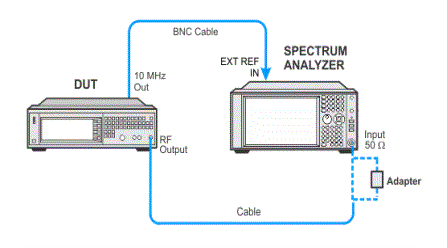
- All test equipment requires a 30 minute warmup period to ensure accurate performance.
- In the following test setup, cables are designated as solid lines and direct connections are designated as dashed lines.
Adjacent Channel Power Ratio (ACPR) is the ratio of the power in a specified bandwidth within an adjacent, offset channel to the average power level in the main channel.
Alternate Channel Leakage Ratio (ACLR) is the ratio of the power in a specified bandwidth within a channel that is two offsets away from the main channel to the average power level in the main channel.
For this test, the DUT generates a W-CDMA and LTE-FDD waveforms. Then the ACPR and ACLR are measured directly with a spectrum analyzer.
|
Test Equipment |
Critical Specifications for This Test |
Recommended Model |
Alternate Models |
|
Spectrum Analyzer |
Noise Floor </= (–91 dBm) |
N9030B Opt 5xx1 |
N9030A Opt 5xx1 |
|
|||
|
|
|

If this performance test fails, perform the following steps in order:
Check the equipment setup (see above). If the setup is incorrect, make the necessary corrections and rerun the performance test.
Refer to the troubleshooting section of the service guide. If you do not have a printed copy of the service guide (Option OBW), one is available either on the CD-ROM that came with your signal generator shipment or search for your signal generator model number on the Keysight website.
If necessary, obtain service from Keysight Technologies. Refer to Contacting Keysight Technologies.
